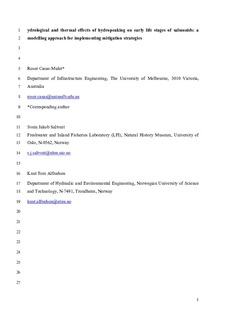| dc.contributor.author | Casas-Mulet, Roser | |
| dc.contributor.author | Saltveit, Svein Jakob | |
| dc.contributor.author | Alfredsen, Knut | |
| dc.date.accessioned | 2018-03-12T09:15:36Z | |
| dc.date.available | 2018-03-12T09:15:36Z | |
| dc.date.created | 2016-10-08T16:02:22Z | |
| dc.date.issued | 2016 | |
| dc.identifier.citation | Science of the Total Environment. 2016, 573 1660-1672. | nb_NO |
| dc.identifier.issn | 0048-9697 | |
| dc.identifier.uri | http://hdl.handle.net/11250/2490040 | |
| dc.description.abstract | Alterations in hydrological and thermal regimes can potentially affect salmonid early life stages development and survival. The dewatering of salmon spawning redds due to hydropeaking can lead to mortality in early life stages, with higher impact on the alevins as they have lower tolerance to dewatering than the eggs. Flow-related mitigation measures can reduce early life stage mortality. We present a set of modelling tools to assess impacts and mitigation options to minimise the risk of mortality in early life stages in hydropeaking rivers. We successfully modelled long-term hydrological and thermal alterations and consequences for development rates. We estimated the risk of early life stages mortality and assessed the cost-effectiveness of implementing three release-related mitigation options (A,B,C). The economic cost of mitigation was low and ranged between 0.7% and 2.6% of the annual hydropower production. Options reducing the flow during spawning (B and C) in addition to only release minimum flows during development (A) were considered more effective for egg and alevin survival. Options B and C were however constraint by water availability in the system for certain years, and therefore only option A was always feasible. The set of modelling tools used in this study were satisfactory and their applications can be useful especially in systems where little field data is available. Targeted measures built on well-informed modelling tools can be tested on their effectiveness to mitigate dewatering effects vs. the hydropower system capacity to release or conserve water for power production. Environmental flow releases targeting specific ecological objectives can provide better cost-effective options than conventional operational rules complying with general legislation. | nb_NO |
| dc.language.iso | eng | nb_NO |
| dc.publisher | Elsevier | nb_NO |
| dc.rights | Attribution-NonCommercial-NoDerivatives 4.0 Internasjonal | * |
| dc.rights.uri | http://creativecommons.org/licenses/by-nc-nd/4.0/deed.no | * |
| dc.title | Hydrological and thermal effects of hydropeaking on early life stages of salmonids: A modelling approach for implementing mitigation strategies | nb_NO |
| dc.type | Journal article | nb_NO |
| dc.type | Peer reviewed | nb_NO |
| dc.description.version | acceptedVersion | nb_NO |
| dc.source.pagenumber | 1660-1672 | nb_NO |
| dc.source.volume | 573 | nb_NO |
| dc.source.journal | Science of the Total Environment | nb_NO |
| dc.identifier.doi | 10.1016/j.scitotenv.2016.09.208 | |
| dc.identifier.cristin | 1390365 | |
| dc.description.localcode | © 2016. This is the authors’ accepted and refereed manuscript to the article. Locked until 5.10.2018 due to copyright restrictions. This manuscript version is made available under the CC-BY-NC-ND 4.0 license http://creativecommons.org/licenses/by-nc-nd/4.0/ | nb_NO |
| cristin.unitcode | 194,64,91,0 | |
| cristin.unitname | Institutt for bygg- og miljøteknikk | |
| cristin.ispublished | true | |
| cristin.fulltext | postprint | |
| cristin.qualitycode | 2 | |

